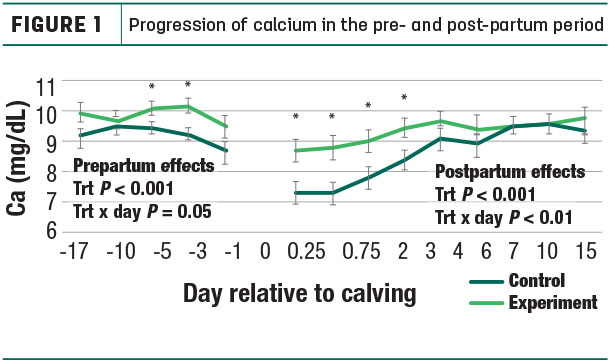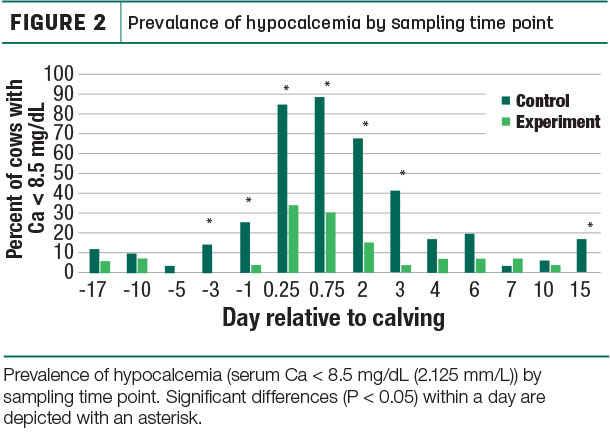Last spring, a trial at Cornell University tested a calcium binder’s efficiency at averting the drop in blood calcium levels at calving and preventing hypocalcemia.
The calcium binder, X-Zelit, showed a clear improvement in calcium status during the transition period.
“I think it will continue to grow and take over the way we feed transition cows in the next five to 10 years,” says Lasse Jakobsen, product expert for Protekta Inc., which distributes the calcium binder.
His expectation is for the product to substitute dietary cation-anion difference (DCAD) treatments and calcium bolus products as the preferred method for preventing hypocalcemia.
How it works
Calcium binders use a new approach for improving transition cow feeding. The strategy is based on limiting the amount of calcium fed to dry cows. With less calcium available from the feed, the cow will adjust its hormones to the low-calcium ration and begin mobilizing calcium from its own bones. In other words, the cow’s natural defense mechanism for preventing hypocalcemia is activated and maintains its blood calcium at a natural level pre- and post-calving.
“Generally, the reaction would happen normally at calving when blood calcium levels drop,” Jakobsen says. “However, making the cow deficient in calcium early stimulates the [parathyroid] hormone to be already up and running before calving.”
Due to the naturally occurring calcium in common feed ingredients, it is almost impossible to create a low-calcium ration using only normal feedstuffs. However, X-Zelit is a calcium binder that binds to calcium in the ration and keeps it from being absorbed in the digestive system.
When the cow calves, it is no longer fed the calcium binder. From that point on, the hormonal system should be primed and capable of absorbing sufficient calcium into the blood and for milk production.
This is a completely different approach than a DCAD diet. The difference between the DCAD and the X-Zelit is clearly observed in the efficiency differences. The X-Zelit will keep the calcium level in a flat line in the periparturient period, which is not observed using the DCAD method.
Cornell University study
X-Zelit has been used in Europe for more than 10 years as an alternative dietary strategy to improving calcium levels in cows. Recently, in the last few years, marketing for the product has begun in North America. When Tom Overton, professor of dairy management at Cornell University, first heard of the product, he became interested in researching the effects of the calcium binder approach on a common low-potassium diet fed in the northeastern U.S.
For his research trial at Cornell, 55 multiparous cows were assigned to either the control or experimental group. In the experimental group, 500 grams per day of X-Zelit was supplemented during the last three weeks prior to calving. Overton estimated the cost of the product amounted to $2 per cow per day. The DCAD level of both rations was 14 to 15 mEq per 100 grams.
“We wanted to determine whether feeding the binder in addition to the diet would improve calcium status, and it certainly did,” Overton says.
Calcium binder advantages
As a result, the values of blood calcium were higher for the X-Zelit-fed group during the prepartum and postpartum period (Figure 1).

The higher calcium level around calving shows the cows’ own defense mechanism for preventing low blood calcium levels had been activated in the experimental group. This improved calcium status and decreased the occurrence of subclinical hypocalcemia (Figure 2).

“I think the most impressive part of our results was the pronounced and positive increases in blood calcium in the post-calving cows,” Overton says.
The trial also showed trends toward positive impacts on reproduction that Overton says needs follow-up and evaluation of milk production.
“Our study wasn’t powered from a statistical standpoint to look at health disorders,” Overton says. “But I think further work should look at those types of issues as well as to see where additional product benefits may be.”
A major benefit Jakobsen says he hears from producers about the calcium binder is increased feeding flexibility; for example, to add first-cutting alfalfa hay to a pre-fresh diet, which is usually higher in potassium and protein.
“I’ve gotten comments on how farmers can really feed what they want to feed and don’t have to worry about the DCAD,” Jakobsen says. “They don’t have to test urine pH or add in calcium, phosphorus or supplemental protein, which are all extra costs.”
Jakobsen says he believes supplementing in a calcium binder may become one of the top ways to feed transition cows.
“There are different strategies farms use to manage calcium metabolism,” Overton says. “DCAD is a tried-and-true, tested strategy. But I think this potentially offers an additional strategy for farms to consider.”
A DCAD diet vs. a calcium binder: How to decide?
While the latest research confirmed what was expected given previous research trials on calcium binders, some transition cow nutritional experts are skeptical this approach may not work in all cases.
“The benefits of using dietary tools, such as negative DCAD balancing during the pre-fresh period, are many—including the ability to prevent subclinical hypocalcemia,” says Dr. Elliot Block, Arm & Hammer senior research fellow and director of technology.
“When managing against transition period challenges, be sure you select the tool that will best accomplish your goals. The No. 1 goal of a negative DCAD strategy is to have healthier cows with higher start-up and peak milk production. When prepartum rations are properly formulated for negative DCAD, more of the total blood calcium becomes available in ionized form, which reduces the risk of subclinical hypocalcemia and other transition period disorders.”
According to these experts, calcium binders chelate, or irreversibly bind, not only cations like calcium but also magnesium and others as well. This potentially runs the risk of creating a deficiency of other minerals outside of calcium levels at calving.
Experts also caution that calcium binder products can bind calcium in the intestine, making it unavailable and thus, not activating normal metabolism. In their opinion the study results do not show the desired rapid decline in blood calcium at calving, which is needed to signal the immune system and energy metabolism systems to “step up.”
“Be cautious about simply keeping blood calcium higher around the time of calving,” Block says. “Evaluate your options and choose nutritional solutions that allow the cow’s normal metabolism to occur. If your goals are healthy, productive cows with enhanced reproductive performance, make wise nutritional choices.” ![]()
PHOTO: Calcium. Courtesy photo.

-
Audrey Schmitz
- Editor
- Progressive Dairyman
- Email Audrey Schmitz







